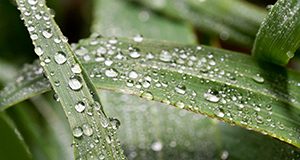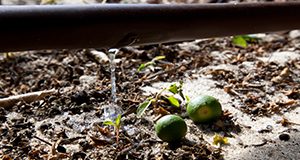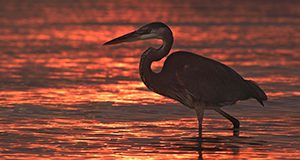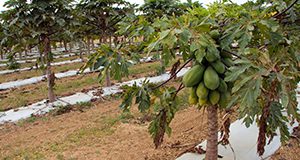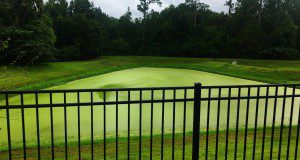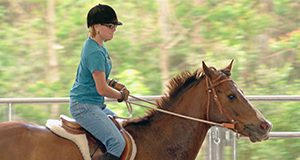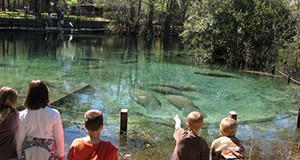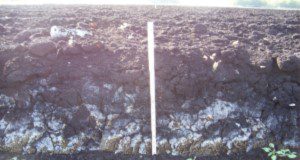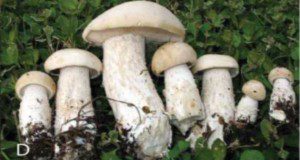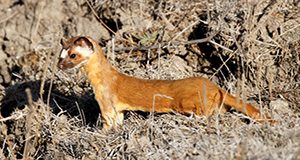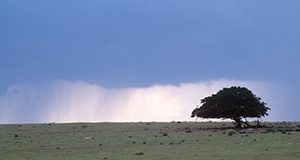Palmer amaranth has become one of the most troublesome weeds in the southeastern US due to its vigorous growth rate, high seed production, and development of resistance to herbicides from multiple modes of action. This 4-page publication illustrates characteristics of this weed to assist in accurate identification, proper management, and development of effective control strategies. Written by Sergio Morichetti, Jason Ferrell, and Pratap Devkota, and published by the UF/IFAS Agronomy Department, revised April 2020.
https://edis.ifas.ufl.edu/ag346
Category: Environment
How to Avoid Common Problems with Leaf Wetness Sensor Installation and Maintenance
Leaf wetness duration is an essential input in disease prediction models and decision support systems in Florida and elsewhere. Incorrect installation or lack of regular maintenance of leaf wetness sensors may lead to errors in plant disease risk monitoring and negative impacts on yield. This 7-page publication provides detailed guidelines for the proper installation and maintenance of leaf wetness sensors and describes the most common problems found in field installations as well as potential solutions. Written by T. B. Onofre, C. W. Fraisse, N. A. Peres, and J. McNair, and published by the UF/IFAS Department of Agricultural and Biological Engineering, February 2020.
https://edis.ifas.ufl.edu/ae538
Basic Tips for Designing Efficient Irrigation Systems
As freshwater resources become increasingly scarce and droughts become more frequent, there is a need for efficient use of water resources. Designing efficient irrigation systems and equipment will not only save money but also conserve water. This 10-page fact sheet discusses factors to consider when designing irrigation systems. Written by Haimanote K. Bayabil, Kati W. Migliaccio, Michael Dukes, and Laura Vasquez, and published by the UF/IFAS Department of Agricultural and Biological Engineering, February 2020.
https://edis.ifas.ufl.edu/ae539
Wading Birds of Northern Belize
Belize is home to over 605 bird species, many of them wading birds popular with bird watchers who enjoy their bright colors and charismatic behavior. Bird-watching is a major contributor to successful wildlife conservation and is important as native habitat loses ground to development. This 4-page fact sheet written by Venetia S. Briggs-Gonzalez, Jorge E. Ruano, Justin R. Dalaba and Frank J. Mazzotti and published by the UF/IFAS Department of Wildlife Ecology and Conservation presents photos and descriptions that will help identify some common and some rare wading birds.
https://edis.ifas.ufl.edu/uw469
White-tailed Deer of Florida
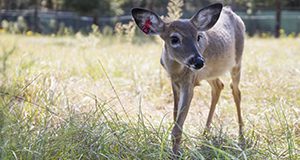
The white-tailed deer (Odocoileus virginianus) is the most economically important big game mammal in North America and Florida. This 12-page fact sheet written by Raoul K. Boughton, Bethany Wight, Samantha Wisely, Karen Hood, and Martin B. Main and published by the UF/IFAS Department of Wildlife Ecology and Conservation provides an overview of the various subspecies of white-tailed deer with populations in Florida and describes their history, biology, and management.
https://edis.ifas.ufl.edu/uw121
Sea Turtle Conservation: 10 Ways You Can Help
All of Florida’s five species of sea turtles are in danger of extinction, largely as a result of people’s actions. Fortunately, however, there are simple steps Florida’s residents and visitors can take to help these remarkable animals. This illustrated 4-page fact sheet written by Jessica E. Swindall, Holly K. Ober, Margaret M. Lamont, and Raymond R. Carthy and published by the UF/IFAS Department of Wildlife Ecology and Conservation provides 10 easy-to-follow suggestions for ways people can reduce harm to sea turtles.
https://edis.ifas.ufl.edu/uw466
ET-Based Irrigation Scheduling for Papaya (Carica papaya) in Florida
Three irrigation scheduling methods (set schedule, ET-based, and tensiometer-based) were tested for papaya production in south Florida. ET-based irrigation scheduling was found to conserve water effectively. This 6-page document primarily focuses on the ET-based irrigation scheduling techniques for papaya under Florida conditions. Written by Haimanote K. Bayabil, Jonathan H. Crane, Kati W. Migliaccio, Yuncong Li, and Fredy Ballen, and published by the UF/IFAS Department of Agricultural and Biological Engineering, March 2020.
https://edis.ifas.ufl.edu/ae540
Sources and Transformations of Nitrogen in Urban Landscapes
With 80% of Florida’s residents living within 10 miles of the coast, Florida’s aquatic resources are directly affected by urbanization. The intent of this new 6-page publication of the UF/IFAS Department of Soil and Water Sciences is to describe the urban nitrogen cycle for a nontechnical audience. Ultimately, this document is intended for individuals working in urban environments and concerned about nutrient pollution and water quality issues, but do not have a technical background and want to improve their understanding of nitrogen cycling. Written by Alexander J. Reisinger, Mary G. Lusk, and Ashley R. Smyth.
https://edis.ifas.ufl.edu/ss681
Fish Population Recruitment: What Recruitment Means and Why It Matters
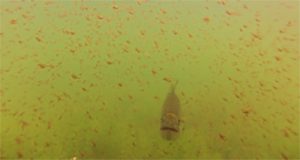
Recruitment, the process by which small fish transition to older, larger life stages, is probably the most important process that regulates populations of fish, but it is complicated to understand. This 6-page fact sheet written by Edward V. Camp, Robert N. M. Ahrens, Angela B. Collins, and Kai Lorenzen and published by the UF/IFAS Program in Fisheries and Aquatic Sciences, School of Forest Resources and Conservation explains the recruitment process in fish populations and why recruitment is so important to fisheries science and management.
https://edis.ifas.ufl.edu/fa222
Insect Bite Hypersensitivity in Horses
Allergic skin disease is a very common cause of itching in horses. The itching can severely affect the horse’s quality of life, leading to the horse wounding itself by biting or scratching, and it can reduce the utility of the horse. This 4-page fact sheet written by Rosanna Marsella, Nicky Craig, Carissa Wickens, and Samantha Brooks and published by the UF/IFAS Department of Animal Sciences explains how to manage allergic skin disease, control itching, treat secondary infections, and prevent the insect bites in the first place.
https://edis.ifas.ufl.edu/an359
Ocean Acidification: Calcifying Marine Organisms
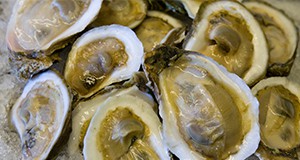
Rising atmospheric carbon dioxide concentration leads to ocean acidification and threatens coastal and marine ecosystems and organisms. This 4-page fact sheet written by Joseph Henry, Joshua Patterson, and Lisa Krimsky and published by the UF/IFAS School of Forest Resources and Conservation, Program in Fisheries and Aquatic Sciences explores the impacts of ocean acidification on calcification, the process corals, bivalves, echinoderms, and planktonic organisms use to build their shells and skeletons. Understanding how ocean acidification affects calcification is important for scientists seeking to determine the real-world implications and impacts of ocean acidification on some of the most important species in the marine environment.
https://edis.ifas.ufl.edu/fa220
Ocean Acidification: Fish Physiology and Behavior
Increased atmospheric carbon dioxide has led to increased levels of dissolved carbon dioxide in the oceans and acidified ocean water, which could have direct effects on the physiology and behavior of fishes. This 5-page fact sheet written by Joshua Patterson, Lisa Krimsky, and Joseph Henry and published by the UF/IFAS School of Forest Resources and Conservation, Program in Fisheries and Aquatic Sciences will summarize the current state of our understanding on the topic, with special emphasis on Florida fishes. It will also address current challenges in understanding the real-world effects of a complex global process using data largely collected on isolated fish in laboratory experiments.
https://edis.ifas.ufl.edu/fa219
How to Properly Dispose of Unwanted Medications
Properly disposing of expired or unused medications can help reduce the prevalence of prescription drug abuse in Florida. It also helps prevent accidental ingestion by children or pets, helps prevent accidentally taking the wrong medication, and prevents medications from entering water sources. This new 3-page publication of the UF/IFAS Department of Soil and Water Sciences provides some dos and don’ts for disposing of your medications. Written by Alexander J. Reisinger.
https://edis.ifas.ufl.edu/ss680
Economic Value of Florida Water Resources: Contributions of Tourism and Recreation to the Economy
Recreation is only one of the benefits people receive from water resources. Water is essential for fisheries and aquaculture, for drinking and bathing, for sanitation, and for spiritual and symbolic purposes, among myriad other uses described in the Economic Value of Florida Water Resources series. This 6-page fact sheet written by Tatiana Borisova, Kurt Oehlbeck, Xiang Bi, Tara Wade, Alan Hodges, Kelly Grogan, and Fe Hei and published by the UF/IFAS is the second part of the series. It discusses the contribution of water-based tourism to the economy in various Florida regions, summarizing a number of economic studies and focusing on freshwater-based recreation, such as canoeing, freshwater angling, wildlife watching, lake- or river-shore hiking, spring diving, and more. Readers can pick and choose the studies most relevant to their geographic area or their area of interest.
https://edis.ifas.ufl.edu/fe1065
Everglades Agricultural Area Soil Subsidence and Sustainability
This 4-page major revision, a publication of the UF/IFAS Department of Soil and Water Sciences, highlights the current status of Histosols within the Everglades Agricultural Area in southern Florida. Over the last century, soils within the region have gradually been lost via oxidation, a process commonly referred to as soil subsidence. The rate of subsidence is gradually declining, due to factors such as increased mineral content in soil, humification, and water management (maintenance of higher water tables). Best Management Practices and crop rotation help slow down the rate of oxidation and promote soil sustainability within the region. Written by Jehangir H. Bhadha, Alan L. Wright, and George H. Snyder.
https://edis.ifas.ufl.edu/ss523
Sea Turtle Conservation: Priorities for Environmental Education Efforts
All five species of sea turtle that occur in Florida are in danger of extinction. This 4-page fact sheet written by Jessica E. Swindall, Holly K. Ober, Margaret M. Lamont, and Raymond R. Carthy and published by the UF/IFAS Department of Wildlife Ecology and Conservation discusses common human actions that are harmful to sea turtles and provides insight on key environmental education topics.
https://edis.ifas.ufl.edu/uw465
Macrocybe titans: The Mushroom Giant of the Western Hemisphere
The aptly named Macrocybe titans, meaning “giant head,” is the largest known gilled mushroom in the Western Hemisphere. This species was originally described from Florida but can be found across the southeastern United States as well as the Caribbean, Central America, and parts of South America. These mushrooms are often found in clusters with the caps growing as large as 3 ft wide and 1–1.5 ft tall! This species was first discovered in Gainesville, Florida, and is generally found near buildings or roads. This new three-page publication of the UF/IFAS Plant Pathology Department describes these giant mushrooms, their discovery, and where to find them. Written by Elena Karlsen-Ayala and Matthew E. Smith.
https://edis.ifas.ufl.edu/pp356
Urban Fertilizer Ordinances in the Context of Environmental Horticulture and Water Quality Extension Programs: Frequently Asked Questions
Excess nitrogen (N) and phosphorus (P) in water bodies are a leading cause of water quality degradation statewide. More than 50 Florida counties and municipalities now have formal fertilizer ordinances, which in some cases include fertilizer blackouts, or bans on the usage of N and P fertilizers during certain times of the year. This 8-page document provides information on the underlying issues of fertilizer use, with an emphasis on an urban setting, and outlines the current state of the science on urban fertilizers and water quality in Florida. Written by Michael D. Dukes, Lisa Krimsky, Mary Lusk, Laurie Trenholm, Bryan Unruh, Michelle Atkinson, and Rao Mylavarapu, and published by the UF/IFAS Department of Agricultural and Biological Engineering, February 2020.
https://edis.ifas.ufl.edu/ae534
Mammalian Carnivores of Florida
Florida is home to several species of animals in Order Carnivora, a group of mammals with teeth adapted to allow them to eat meat. Many of them, like panthers, you probably know about, and some, like raccoons, you may see regularly. But did you know Florida hosts two separate species of foxes? Two different skunks? Weasels? This 20-page fact sheet written by Raoul Boughton, Bethany Wight, Elizabeth Pienaar, and Martin B. Main and published by the UF/IFAS Department of Wildlife Ecology and Conservation provides an overview of the mammalian carnivores of Florida from panthers to mink.
https://edis.ifas.ufl.edu/uw464
What Does Florida Weather during the Past 20 Years Look Like?: Florida Weather Represented by the Florida Automated Weather Network (FAWN)
This 8-page document gives an overview of Florida temperature and rainfall during the past 20 years based on historical FAWN data to provide information about the temporal and spatial trends of Florida weather and the frequency and size of extreme weather events such as heavy rainfall and drought. This document also investigates the characteristics of drought and heavy rainfall in relation to hurricanes and tropical storms. Written by Satbyeol Shin, Young Gu Her, Geraldina Zhang, and William Lusher, and published by the UF/IFAS Department of Agricultural and Biological Engineering, January 2020.
https://edis.ifas.ufl.edu/ae537

